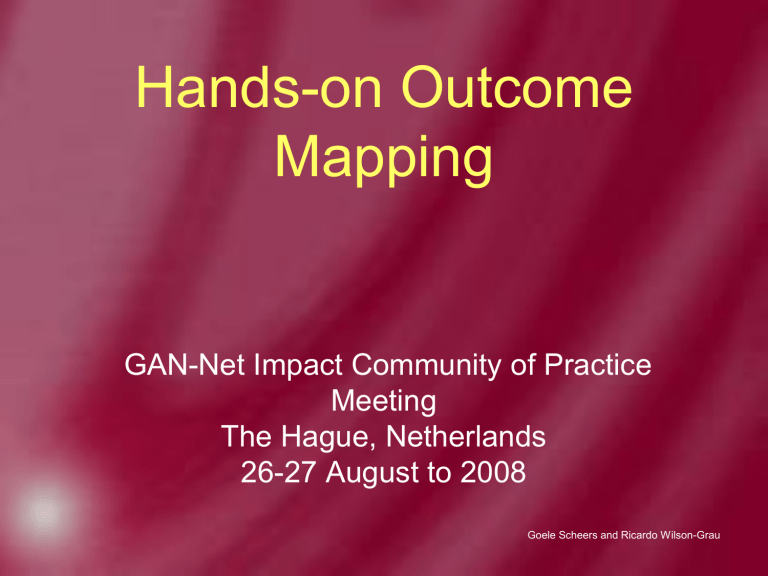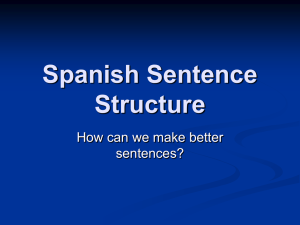Default - Outcome Mapping Learning community

Hands-on Outcome
Mapping
GAN-Net Impact Community of Practice
Meeting
The Hague, Netherlands
26-27 August to 2008
Goele Scheers and Ricardo Wilson-Grau
Pre-Exercise
As we wait for people to settle down, please draw up a list of the internal and external stakeholders in your work.
Be as specific as possible in identifying the actors internally or externally who have a vested interest in the work you do.
Thanks to Enrique Mendizabal Goele Scheers and Ricardo Wilson-Grau
Purpose
Stimulate discussion amongst GANs, donors and consultants on the potential of Outcome
Mapping as a planning, monitoring and evaluation methodology for GANs.
Goele Scheers and Ricardo Wilson-Grau
Intended results
Greater clarity about the strengths and weaknesses of Outcome Mapping in the light of:
1.
GANs need for a practical planning tool, performance assessment and impact measurement
2.
Donors’ reporting and accountability requirements
3.
Consultants’ interest and ability to use outcome mapping
Goele Scheers and Ricardo Wilson-Grau
Activities
As a means of sharing with your our experiences in using Outcome Mapping in planning, monitoring and evaluating GANs (and other types of organisations), we will lead you through three quick exercises, each one preceded by a brief conceptual introduction.
After the exercises, we will wrap up with a discussion.
Goele Scheers and Ricardo Wilson-Grau
Goele Scheers and Ricardo Wilson-Grau
Outcome Mapping
A methodology developed by the Evaluation
Unit at the Canadian International
Development Research Center (IDRC)
IDRC grants annually over US$100 million to research organisations around the world.
They developed Outcome Mapping between
1998 and 2000 as a response
to three difficulties they faced.
Goele Scheers and Ricardo Wilson-Grau
Understand the impact of their grantees
Goele Scheers and Ricardo Wilson-Grau
Measure the unmeasurable
Goele Scheers and Ricardo Wilson-Grau
Foster local ownership
Goele Scheers and Ricardo Wilson-Grau
As the solution
Planning : Intentionally design your strategy in relation to the broader development context but aiming at achievements within your sphere of influence: the social actors who are the key protagonists of development ,
“boundary partners”.
Monitoring : Monitor for “outcomes”: the changes in boundary partners because you will only have impact if they change what they do and how they do it. Also includes appreciating the significance of the changes and how you influenced them.
Goele Scheers and Ricardo Wilson-Grau
As the solution
Evaluation : Understand the impact of the changes in the behaviour, relationships and actions of boundary partners – in their policies and practices – and how they contribute to improving people’s lives or the state of the environment.
Goele Scheers and Ricardo Wilson-Grau
Exercise Boundary Partners
Who do you aim to support and influence?
Those individuals, groups, and organizations – from civil society, government or business – with whom you:
Interact directly to effect change
Anticipate opportunities to support or influence them
Engage in mutual learning
Goele Scheers and Ricardo Wilson-Grau
Boundary
Partners
Ultimate beneficiaries
Thanks to Paul Crawford
IMPACT
OUTCOMES
OUTPUTS
RESOURCES
SPHERE OF
CONTROL
SPHERE OF
INFLUENCE
SPHERE OF
CONCERN
You
Strategic partners
Strategic partners
Goele Scheers and Ricardo Wilson-Grau
Exercise #1
Select from your list of stakeholders those you consider to be “boundary partners”.
In pairs with the person sitting next to you:
– Explain to each other why you consider the individuals, groups or organisations you have selected are your boundary partners
– Explain why you consider that the other stakeholders are not boundary partners
In plenary we will discuss a couple of examples.
Goele Scheers and Ricardo Wilson-Grau
Boundary partners in summary
The essence of the Outcome Mapping PME methodology is to focus on changes in these social actors who are protagonists of impact and are beyond the control but within the influence of your organisation.
You distinguish boundary partners from all sorts of strategic partners – individual and organisational allies – with whom you work.
You do not control strategic partners and do not intend to influence them to change.
Some actors, however, may be both.
Goele Scheers and Ricardo Wilson-Grau
Exercise on concept of “outcome”
Outcomes are defined as observable and significant changes in a boundary partner.
The changes can be internal or external to your organisation.
Goele Scheers and Ricardo Wilson-Grau
Internal outcome
Observable change (in the behaviour, relationships, activities, actions) in a boundary partner that is in line with the impact envisioned in your vision and mission.
Internal outcomes are not changes that represent doing more or better. They are qualitatively different; they are developmental.
Goele Scheers and Ricardo Wilson-Grau
Example from GWP
GWP-SEA Steering Committee and prominent Singapore social actors agreed to form GWP-Singapore. The active participation of Singapore not only makes the geographical coverage of Southeast
Asia almost complete but significanly strengthens the partnership, in terms of access to knowledge on water resources management.
Who? Did what? Where? When?
Goele Scheers and Ricardo Wilson-Grau
External outcome
Observable change (in patterns of behaviour, relationships, activities, actions) in a boundary partner outside of your organisation that is in line with the impact envisioned in your vision and mission.
Often these changes are in the boundary partner’s policies or practices.
Goele Scheers and Ricardo Wilson-Grau
Example from GWP
At the beginning of 2008, the National Water
Resources Board of the Philippines agreed to discuss and develop new policies for light handed regulation for small water providers, cooperatives and community-based associations.
The policies include new arrangements for regulating small water providers, specifically relating to registration and tariff-setting.
Goele Scheers and Ricardo Wilson-Grau
Exercise #2
Individually, select one boundary partner from the list you made at the beginning of the session and in a sentence or two describe an outcome you have influenced in the recent past.
The change must be observable and verifiable and can be in their behaviour, relationships, policies, practices or other actions or activities.
Goele Scheers and Ricardo Wilson-Grau
This time, with the person sitting on your other side, read and comment each other’s outcomes. Do they describe who changed, what they changed when and where?
We will then have questions and answers and a brief summary.
Goele Scheers and Ricardo Wilson-Grau
Outcomes in summary
Outcome Mapping offers the possibility to assess the results of the interaction between the network members
Stimulates the learning process within a network and is highly participatory.
OM is very useful for networks, because it is a systemic, non-linear approach and because it is a very flexible tool, that takes into account unexpected results
Goele Scheers and Ricardo Wilson-Grau
Exercise on
Outcome Challenge
A description of the observable changes in a boundary partner if you are extremely successful . The “challenge” is for you to influence, support, facilitate or in some other way assist these optimal changes.
What changes are being sought in each one of your boundary partners?
Goele Scheers and Ricardo Wilson-Grau
Outcome challenge example: GPPAC Network
Members will be implementing activities in
Peace and Conflict Resolution Education
(PCRE) (both formal and informal education) that will bridge the gap between practice and theoretical research.
They will also be undertaking PCRE using the resources and lessons learned through the
Knowledge Generation and Sharing programme. They will be making the case for
PCRE by demonstrating that PCRE leads to attitude changes that are essential for the establishment of a culture of peace.
Goele Scheers and Ricardo Wilson-Grau
An outcome challenge is ambitious. It describes the deepest possible transformation but without losing sight of the reality of the context and what can be achieved in the coming five years.
An outcome challenge incorporates multiple changes within a single statement.
Change
A
Change
B
Outcome
Challenge
Change
C
Change
D
Goele Scheers and Ricardo Wilson-Grau
Exercise #3
Individually, select a boundary partner and formulate in two or three sentences the observable changes in that social actor’s behaviour, relationships, activities, or actions that potentially could be achieved if you are extremely successful in influencing, supporting, facilitating or in some other way assisting the actor over the next 3-5 years.
Goele Scheers and Ricardo Wilson-Grau
Exercise #3… continued
Keep in mind that outcome challenges are phrased so that they capture what the social actor would be doing differently if you achieve your full potential as a facilitator of change.
In pairs, discuss each other’s outcome challenges.
Are you both satisfied that there is a solid balance between realistic and optimistic?
Goele Scheers and Ricardo Wilson-Grau
Outcome challenges summary
Impact – long-term, sustainable improvement in the conditions of human beings and the conservation of the environment – is the result of processes of changes in multiple social actors intentionally or unintentionally, directly or indirectly, in a minor or major way reinforcing each other.
Outcome challenges permit you to visualise how to influence a processes of change.
Goele Scheers and Ricardo Wilson-Grau
In our experience, we have found that
Outcome Mapping is inappropriate in situations where relationships of cause and effect are known.
Outcome Mapping is not especially useful, for example, if the results are to build a bridge, equip rural schools or distribute condoms.
It is most useful in complex, open and dynamic situations where results are unpredictable.
Goele Scheers and Ricardo Wilson-Grau
So, when relationships of cause and effect between activities and results are unknown or even perhaps unknowable, Outcome
Mapping can be a useful PME tool.
Consequently, Outcome Mapping is an option for human rights campaigning, policy advocacy, overcoming gender, racial, ethnic or other forms of discrimination, or changing community practices.
Goele Scheers and Ricardo Wilson-Grau
Final discussion
You will remember the results we aimed for.
Who has thoughts on these questions on
Outcome Mapping?
1.
To what extent does OM have the potential to serve your PME needs as a GAN?
2.
For donor’s, what is the potential of OM to meet or modify your reporting and accountability requirements
3.
And for consultants, how interested might you be in developing the ability to use OM?
Goele Scheers and Ricardo Wilson-Grau
Thank you!
For more information:
IDRC Evaluation Unit : http://www.idrc.ca/en/ev-26586-201-1-DO_TOPIC.html
Outcome Mapping community of practice: www.outcomemapping.ca
Us: g.scheers@conflict-prevention.net
ricardo.wilson-grau@inter.nl.net
Goele Scheers and Ricardo Wilson-Grau








